 Hastings District
Council
Hastings District
Council
Civic Administration Building
Lyndon Road East, Hastings
Phone: (06) 871
5000
Fax:
(06) 871 5100
WWW.hastingsdc.govt.nz
Open
A G E N D A
Works and Services Committee MEETING
|
Meeting Date:
|
Thursday,
28 February 2019
|
|
Time:
|
1.00pm
|
|
Venue:
|
Council
Chamber
Ground Floor
Civic
Administration Building
Lyndon Road
East
Hastings
|
|
Committee Members
|
Chair: Councillor
Watkins
Mayor Hazlehurst
Councillors Barber, Dixon, Harvey, Heaps (Deputy Chair), Kerr, Lawson, Lyons,
Nixon, O’Keefe, Poulain, Redstone, Schollum and Travers (Quorum
= 8)
|
|
Officer
Responsible
|
Group Manager: Asset Management
– Craig Thew
|
|
Committee
Secretary
|
Christine Hilton (Ext 5633)
|
Works and Services Committee
Fields of Activity
The development of operational policy and the oversight of operations
in the area of infrastructure works, tenders, procurement, including (but not
limited to) the following activities:
·
Three-Waters
Infrastructure (Water, Wastewater, Stormwater)
·
Property
ownership, management, renewals, upgrades and developments
·
CBD
upgrades physical works
·
Roading
and transport operations (including Capital infrastructure development for
bridges, roads and footpaths including cycleways)
·
Solid
waste operations (including refuse and recycling disposal and recycled
materials)
·
Water,
wastewater and stormwater (including public drainage and watercourses)
·
Infrastructure
service provision
·
Emergency
Management
·
Tenders
·
Transport
Strategy (including, public transport, cycling, cars, walking and other modes)
·
Overview
of the implementation of major projects including:-
-
Model Communities Project
- Havelock
North Streams
·
And other projects as delegated by Council from time to
time
Membership
Chairman appointed by the Council
Deputy Chairman appointed by the Council
The Mayor
All Councillors
Quorum – 8 members
DELEGATED POWERS
General Delegations
1. Authority to exercise
all of Council powers, functions and authorities (except where delegation is
prohibited by law or the matter is delegated to another committee) in relation
to all matters detailed in the Fields of Activity.
2. Authority to
re-allocate funding already approved by the Council as part of the Long Term
Plan/Annual Plan process, for matters within the Fields of Activity provided
that the re-allocation of funds does not increase the overall amount of money
committed to the Fields of Activity in the Long Term Plan/Annual Plan.
3. Responsibility to
develop policies, and provide financial oversight, for matters within the
Fields of Activity to provide assurance that funds are managed efficiently,
effectively and with due regard to risk.
4. Responsibility to
monitor Long Term Plan/Annual Plan implementation within the Fields of Activity
set out above.
Public Drainage and Watercourses
5 Authority to
exercise the functions, duties and powers of the Council under Sections 446,
447, 451, 461, 467, and 468 of the Local Government Act 1974 (Sewerage and
Storm Water Drainage).
6. Authority to
exercise the functions, duties and powers of the Council under Part 29 (Land
Drainage and Rivers Clearance) and Part 29A (Divestment of Land drainage
schemes and water race schemes) of the Local Government Act 1974.
7. Authority to hear
and determine submissions concerning the Council’s requirements for
owners of private land to do works associated with private drains (Section 459
Local Government Act 1974).
8. Authority to hear
and determine objections to the construction, by Council, of a private drain
(Section 460 Local Government Act 1974).
9. Authority to make
declarations of private drains to be public drains (Section 462 Local
Government Act 1974).
10. Authority
to exercise the functions, duties and powers of the Council under Sections 195
and 196 of the Local Government Act 2002 (Discharge of sewage and trade
wastes).
Water Supply
11. Authority to exercise the
functions, duties and powers of the Council under Subpart 1 (assessments of
water and sanitary services) and Subpart 2 (obligations and restrictions
relating to provision of water services) of Part 7 of the Local Government Act
2002.
Waste Management
12. Authority
to exercise the functions, duties and powers of the Council in relation to
waste management, including power to adopt waste management and waste
minimisation plans under the Waste Minimisation Act 2008.
Roading
13. Authority to exercise all of
the Council’s powers under the Local Government Act 1974 the Transport
Act 1962, the Land Transport Act 1998 and the Land Transport Management Act
2003 in relation to roads.
14. Authority to approve policy
guidelines for the initial naming of roads, and for the alteration of the name
of any road, within the District.
15. Authority to recommend to
the Council, after consultation with the Hastings District Rural Community
Board (where appropriate), that the name of a road or part of a road be
changed.
16. Authority to exercise the
functions, duties and powers of construction, maintenance and control of roads
delegated to the Council under Sections 62 and 63 of the Government Roading
Powers Act 1989.
17. Power to resolve that land held
as a road reserve be dedicated as road (Section 111 Reserves Act 1977).
Bylaws
18. Authority to
monitor any Council bylaws relating to matters within the Fields of Activity
and to recommend any amendments or additions to those bylaws to the Planning
and Regulatory Committee for review and consideration.
HASTINGS DISTRICT COUNCIL
Works and Services Committee MEETING
Thursday, 28 February 2019
|
VENUE:
|
Council Chamber
Ground Floor
Civic Administration Building
Lyndon Road East
Hastings
|
|
TIME:
|
1.00pm
|
|
A G E N D A
|
1. Apologies
At the close of the agenda no
apologies had been received.
At the close of the agenda no
requests for leave of absence had been received.
2. Conflict
of Interest
Members need to be vigilant to
stand aside from decision-making when a conflict arises between their role as a
Member of the Council and any private or other external interest they might
have. This note is provided as a reminder to Members to scan the agenda
and assess their own private interests and identify where they may have a
pecuniary or other conflict of interest, or where there may be perceptions of conflict
of interest.
If a Member feels they do
have a conflict of interest, they should publicly declare that at the start of
the relevant item of business and withdraw from participating in the
meeting. If a Member thinks they may have a conflict of interest,
they can seek advice from the General Counsel or the Democratic Support Manager
(preferably before the meeting).
It is noted that while Members can
seek advice and discuss these matters, the final decision as to whether a
conflict exists rests with the member.
3. Confirmation
of Minutes
Minutes of the
Works and Services Committee Meeting held Tuesday 20 November 2018.
(Previously circulated)
4. Napier Road Cycle
Options 7
5. Converting
Decorative luminaires to LED luminaires 17
6. Te Ara Kahikatea
(Whakatū Arterial Link) - Final Update 27
7. Asset Management
Activities Update 37
8. Additional
Business Items
9. Extraordinary
Business Items
REPORT TO: Works
and Services Committee
MEETING DATE: Thursday 28
February 2019
FROM: Strategic Transport Engineer
Eynon
Phillips
SUBJECT: Napier
Road Cycle Options
1.0 SUMMARY
1.1 The
purpose of this report is to obtain a decision from the Council on the
preferred option for cycle facilities along Napier Road. Council aims to
provide a safe cycling facility along the rural section of Napier Road, between
Havelock North and the recently completed Whakatu Arterial, appropriate for the
expected user group.

1.2 This
proposal arises from the iWay 10-Year Plan. The vision for the iWay programme
is: Hastings District has a safe, attractive and connected cycle network in a
‘complete streets’ setting, that gives people of all ages and
abilities more mobility choices and a higher quality of life. This requires
several steps, one of which is improving connections between district urban
areas, including Clive, Whakatu, and Havelock North.
1.3 The
completion of the Whakatu Arterial is expected to lead to an increase in
traffic on Napier Road, increasing the need for treatment on this route to improve
safety for cyclists.
1.4 The
Council is required to give effect to the purpose of local government as
prescribed by Section 10 of the Local Government Act 2002. That purpose is to
meet the current and future needs of communities for good quality local
infrastructure, local public services, and performance of regulatory functions
in a way that is most cost–effective for households and businesses. Good
quality means infrastructure, services and performance that are efficient and
effective and appropriate to present and anticipated future circumstances.
1.5 The
objective of this decision relevant to the purpose of Local Government is local
infrastructure which contributes to public health and safety, supports growth,
connects communities, activates communities and helps to protect the natural
environment by providing accessible transport options.
1.6 This
report concludes by recommending Option 3b: Wider Buffered On-Road Cycle Lane +
Option 4: Romanes to Thompson Shared Path.
2.0 BACKGROUND
2.1 Napier
Road serves as the most direct route between Havelock North and Whakatu-Clive
and on to Napier. As such it was identified in the iWay 10-Year plan as one of
the top five routes for cycleway treatment. The completion of the Whakatu
Arterial is expected to lead to an increase in traffic on Napier Road which
only increases the need to improve safety and accessibility for cyclists along
this route.
2.2 Council
adopted the current iWay Strategy in 2017. In 2018 an independent review of the
cycleway priorities was carried out using similar criteria to the original but
with different weighting and scoring methods. The table below shows all the
projects considered with both the 2017 and 2018 rankings. The review confirmed
that the rankings were largely robust with only minor differences between the
two systems. The table also shows the current status of all projects. Napier
Road moved from 6 to 5 due to the completion of Brookfields Road.

2.3 Council
commissioned ViaStrada to carry out an investigation and analysis of the Napier
Road route and potential options, identifying
· The likely predominant user group
· Any physical/site constraints
· Advantages and disadvantages of each option
· A high-level estimate for each option
· The recommendation of a preferred option
2.4 Currently
the only provision for cyclists on Napier Road is a sealed shoulder of
variable, often narrow, width. This can only appeal to “strong and
fearless” cyclists, about 1% of the population. Currently about 70 people
cycle along Napier Road each day.
2.5 Due
to the length and location of Napier Road, to cycle the route requires a high
level of fitness and the majority of the connections are high volume and high
speed roads. The most viable target audience for this cycle facility are
primarily commuters who are “enthused and confident” cyclists.
2.6 The
southern section of Napier Road between Romanes Drive and Thompsons Road is
closer to the urban area of Havelock North and this area is undergoing
residential development. It also has many tourist attractions and a pre-school
in close vicinity. As such it could target residents and tourists who are more
likely to be “interested but concerned” and less experienced
cyclists, as well as pedestrians.
3.0 CURRENT
SITUATION
3.1 The
4.5 km section of Napier Road between Romanes Drive and State Highway 2 serves
as the direct link between Havelock North and Whakatu-Clive-Napier. It is
designated as an Arterial and heavy vehicle route.
3.2 Current
traffic volumes average around 4,000 vehicles per day (vpd), though this is
expected to increase to 6,000vpd within the next eight years. The speed limit
was recently changed from 100km/h to 80km/h, and the current 85th percentile
speed is 87km/h.
3.3 Traffic
lanes are generally 3.3m wide and were recently resurfaced. Sealed shoulders
are provided on both sides and average 0.3m wide, though there is a large
variation with the width ranging from 0.1m to 2.5m.
3.4 The
road reserve is 20.1m wide. Generally wide and flat grass verge, though this is
narrowed in some locations with hedges and across a culvert.
3.5 The
original rough order cost estimate for this project was for between $700,000
and $900,000. This is part of the iWay programme with a total budget of $2.7
Million over the next three years.
4.0 OPTIONS
4.1 Option
1: Two-Way Shared Path on One Side
A 2.5m wide separated
concrete path on the west side of Napier Rd.
Estimated cost $1.8M

4.2 Option
2: One-Way Shared Path on Each Side
A 1.5m wide separated
concrete path on each side of Napier Road.
Estimated cost $2.5M

4.3 Option
3a: Buffered On-Road Cycle Lane
A 1.5m wide on-road
cycle lane with 0.5m wide painted buffer on each side of Napier Road.
Estimated cost $1.5M

4.4 Option
3b: Wider Buffered On-Road Cycle Lane
A 1.5m wide on-road
cycle lane with 1.0m wide painted buffer on each side of Napier Road.
Estimated cost $1.6M

4.5 Option
4: Romanes to Thompson Two-Way Shared Path
A 2.5m wide separated
concrete path on the east side of Napier Road between Romanes Drive and
Thompsons Road.
This option can be
integrated with any of the other options for an estimated additional cost of
$160,000.

4.6 Option
5: Do Nothing
Retain the existing
sealed shoulders, average 0.3m wide (range from 0.1m to 2.5m). No cost.
5.0 SIGNIFICANCE
AND ENGAGEMENT
5.1 These
options were presented to the Active Transport Group meeting on 12 December
2018.
5.2 Option
1 was criticised because cyclists from both directions would share a path and
would have to cross the road at some stage, making it unsafe.
5.3 Option
2 was considered by many to be the safest option.
5.4 Either
Option 3 was the preferred option as they were seen as a good compromise
between cost and infrastructure provision. The wider buffer of Option 3b was
desirable due to the amount of heavy vehicles on the route.
5.5 There
was disagreement on the need for Option 4 and the demand from tourists.
6.0 ASSESSMENT
OF OPTIONS (INCLUDING FINANCIAL IMPLICATIONS)
6.1 Option
1: Two-Way Shared Path on One Side
A 2.5m wide separated
concrete path on the west side of Napier Rd.
Estimated cost $1.8M
This has a high
degree of separation from adjacent traffic and will feel safer for
less-confident cyclists. It avoids crossing Lawn Road. It caters well to
recreational users and can be shared by pedestrians.
However, it is the
least safe option at side roads and driveways, due to drivers not expecting
cyclists coming from the contra-flow direction, and visibility at driveways is
limited by hedges. It is not attractive to experienced cyclists whom may choose
to remain on road. It may be misused, e.g. by slower farm vehicles or
motorcycles. Cyclists travelling in the contra-flow direction can confuse
oncoming traffic, particularly at night.
6.2 Option
2: One-Way Shared Path on Each Side
A 1.5m wide separated
concrete path on each side of Napier Road.
Estimated cost $2.5M
This has a high
degree of separation from adjacent traffic and will feel safer for
less-confident cyclists. It caters well to recreational users and is safer than
a two-way option in terms of interactions at side roads and driveways.
However, it is less
appropriate for sharing with pedestrians as it is narrower and pedestrians are
likely to travel in both directions. Visibility at driveways is still limited by
hedges. It is not attractive to experienced cyclists whom may choose to remain
on road. It may be misused, e.g. by slower farm vehicles or motorcycles.
Conflict point crossing Lawn Road. Most costly option.
6.3 Option
3a: Buffered On-Road Cycle Lane
A 1.5m wide on-road
cycle lane with 0.5m wide painted buffer on each side of Napier Road.
Estimated cost $1.5M
This caters well to
existing road cyclists and confident commuter cyclists. Safest option at side
roads and driveways. Consistent with the connecting routes and the least costly
option.
This option meets the
Austroads desirable width for on-road cycle lanes in an 80km/h environment
(2.0m including the painted buffer).
However, there is
less separation from adjacent traffic and it will not be attractive to
less-confident cyclists whom will feel less safe. Does not cater to
recreational users or pedestrians. May be misused, e.g. for parking, slow
vehicles, passing etc.
6.4 Option
3b: Wider Buffered On-Road Cycle Lane
A 1.5m wide on-road
cycle lane with 1.0m wide painted buffer on each side of Napier Road.
Estimated cost $1.6M
This caters well to
existing road cyclists and confident commuter cyclists. Safest option at side
roads and driveways. Consistent with the connecting routes. With wider
separation from adjacent traffic than Option 3a it will be more attractive to
and safer for less-confident cyclists.
This option exceeds
the Austroads desirable width for on-road cycle lanes in an 80km/h environment,
but still falls within the acceptable range (1.8-2.7m including the painted
buffer).
However, it does not
cater to recreational users or pedestrians. May be misused, e.g. for parking,
slow vehicles, passing etc.
6.5 Multi-criteria
Analysis
A multi-criteria
analysis was carried out by ViaStrada on the four options above. They included
five criteria with inputs and weights assigned based on judgement. Results are
shown in the table below.

The criteria were:
· Cost
· Maintenance requirements
· Target audience
· Safety
· Environment
The analysis shows
the on-road options were preferred, with Option 3b scoring slightly higher than
Option 3a.
6.6 Budget
implications
The original rough
order cost for this project was estimated to be between $700,000 and $900,000.
This is substantially lower than the latest estimates, as it did not include:
· Crossings at Lawn Road and Thompson Road.
· Integration with driveways.
· Wider facilities.
· Separated path options.
Options 1, 3a, and 3b
would take up half to two-thirds of the iWays budget for the next three years
($2.7M). Any of these would allow for previously committed projects to go
ahead, as well as a number of minor improvements such as roundabout upgrades.
Option 2 would exceed
the entire non-committed iWays budget for the next three years.

6.7 Programme
implications
The other major iWays
projects programmed for the next three years are the roundabouts on St Aubyn
Street and Southampton Street. These had an original rough order cost estimate
of $1.44M combined.
However after a full
safety and accessibility review of these roundabouts there is the possibility
to implement low cost improvements, e.g. line marking changes and minor
improvements, at least in the short term for the majority of the intersections.
This is likely to cost less than $20,000 per roundabout, leading to a
considerable cost saving.
6.8 Option
4: Romanes to Thompson Two-Way Shared Path
A 2.5m wide separated
concrete path on the east side of Napier Road between Romanes Drive and
Thompsons Road. This option can be integrated with any of the other options.
Estimated cost is an
additional $160,000.
This caters well to
recreational users and pedestrians at the southern end of the route, where
proximity to the urban area of Havelock North and several tourist destinations
make this a higher priority user group.
6.9 Option
5: Do Nothing
Retain the existing
sealed shoulders, average 0.3m wide (range from 0.1m to 2.5m).
Estimated cost $NIL
This caters only to
existing strong and fearless cyclists and does not provide a safe cycle
facility on Napier Road.
7.0 PREFERRED
OPTION/S AND REASONS
7.1 Option
3b: Wider Buffered On-Road Cycle Lanes + Option 4: Romanes to Thompson Two-Way
Shared Path
7.2 This
caters well to existing road cyclists and confident commuter cyclists along the
length of the route. It is the safest option at side roads and driveways and is
consistent with most of the connecting routes.
7.3 With
wider separation from adjacent traffic than Option 3a it will be more
attractive to and safer for less confidant cyclists.
7.4 This
option also caters well to recreational users and pedestrians at the southern
end of the route, where proximity to the urban area of Havelock North, a
pre-school, and several tourist destinations make this a higher priority user
group.
|
8.0 RECOMMENDATIONS AND
REASONS
A) That
the report of the Strategic Transport Engineer titled “Napier
Road Cycle Options” dated 28/02/2019 be received.
B) That Option 3b: Wider Buffered On-Road Cycle Lane + Option 4:
Romanes to Thompson Two-Way Shared Path be accepted as the preferred option.
With the reasons for this decision
being that the objective of the decision will contribute to meeting the
current and future needs of communities for good quality local infrastructure
in a way that is most cost-effective for households and business by:
i) Providing accessible transport options.
|
Attachments:
There are no
attachments for this report.
REPORT TO: Works
and Services Committee
MEETING DATE: Thursday 28
February 2019
FROM: Transportation Asset Manager
Marius van Niekerk
Transportation Operations Manager
Adam
Jackson
SUBJECT: Converting
Decorative luminaires to LED luminaires
1.0 SUMMARY
1.1 The
purpose of this report is to obtain a decision from the Council on converting
decorative luminaires to LED luminaires within the residential areas of
Hastings, Havelock and Flaxmere.
1.2 This
proposal arises from the streetlight to LED luminaire conversion programme
previously approved by Council and the high cost of purchasing decorative LED luminaires
that will retain the street character aspects of the light fitting.
1.3 The
Council is required to give effect to the purpose of local government as prescribed
by Section 10 of the Local Government Act 2002. That purpose is to meet the
current and future needs of communities for good quality local infrastructure,
local public services, and performance of regulatory functions in a way that is
most cost–effective for households and businesses. Good quality means
infrastructure, services and performance that are efficient and effective and
appropriate to present and anticipated future circumstances.
1.4 The
objective of this decision relevant to the purpose of Local Government is to
provide good quality infrastructure for households and business by:
· Improving
illumination on residential, collector and arterial roads.
· Reduce
electricity consumption associated with providing street lighting.
· Reduce
ongoing maintenance costs associated with street lighting.
1.5 This
report concludes by recommending to convert suitable decorative luminaires to
standard LED luminaires by minor modification of existing poles.
2.0 BACKGROUND
2.1 Council
is currently converting existing residential, collector and arterial road luminaires
to LED luminaires using an 85% subsidy offer from New Zealand Transport Agency
(NZTA).
2.2 The
conversion of all luminaires to LED luminaires have been included in the LTP.
2.3 With
NZTA providing an 85% subsidy offer, this programme has been accelerated to
occur over six years, commencing in 2015 and concluding in 2021.
2.4 Decorative
lights as shown below are excluded from the NZTA subsidy offer but minor
modifications to the pole to fit standard type LED lights are included.

2.5 There
are a number of subdivisions where decorative poles and lights have been
installed. The total number of lights, consisting of various decorative
designs, are 325 poles and lights. Refer to the pictures below for examples of
existing lights.(Excludes CBD areas of Hastings and Havelock).
2.6 There
are 60 poles and lights which consist of decorative type Victorian lantern type
and modern bowl type lights which are shown below (Respectively Kingsgate and
Woodlands drive subdivisions). These poles are generally 4m – 4.5m high
and are spaced at closer spacing than overhead luminaires which are typically
installed at 6m – 8m height and 50m or greater spacing between poles.
2.7 The
Hastings District Engineering Code of Practice has been amended to ensure any
new subdivisions proposing decorative street lights complies with P category
standard LED type luminaires.

2.8 Woodlands
Drive subdivision streetlight examples:

2.9 Kingsgate
Subdivision streetlight examples:
2.10 P category standard
LED type luminaires have optimum performance when installed at a height of 8m
or higher and are able to provide sufficient light at pole spacing of up to 90m.
2.11 The 60 luminaires in
the Woodlands drive and Kingsgate subdivisions cannot be converted to utilise a
standard P category LED without significant modification to the pole to
increase the height. With this proposed modification to increase the height, it
is highly unlikely that the existing pole foundations will be sufficient.
2.12 If full pole
replacement is considered the 54% funding assistance rate (FAR) will apply to
all costs associated with replacing the pole. This is currently not budgeted
for in the LTP.
2.13 As the existing luminaires
and poles still have significant remaining life left, it is recommended to run
these units to failure or when spare parts become unavailable and then do a
full pole and light upgrade in 10 to 20 years’ time.
2.14 The remaining 265
subdivision decorative luminaires consists of typically a green powder coated
steel pole with the existing decorative light mounted on a steel arm, typically
at a height of 6m – 8m and at spacing’s of between 40 to 60m. These
luminaires are able to be easily converted to a standard LED P category fitting
with only minor modifications to the pole arm. (Typically Brookvale Road,
Palmbrook Ave and Williams Street developments)
2.15 It is proposed that
the steel arm is cut at a suitable position – generally just behind the
existing light and that a standard P or V category LED light which is colour
matched to the pole, is fitted onto the existing arm.

2.16 The proposed
replacement light units and pole modifications qualify for the 85% subsidy
offer from NZTA.
3.0 CURRENT
SITUATION
3.1 The
cost of replacing the existing decorative luminaires with similar decorative
LED luminaires (refer 2.2) has been assessed and a number of concerns regarding
the replacement of these luminaires have been identified.
3.2 The
cost of these units are generally more than double (±$1100) than the
cost of replacing a normal P category luminaires (±$350). NZTA has
confirmed that the purchase of decorative LED luminaires do not qualify for the
85% subsidy.
3.3 A
number of poles have decorative shapes with goose necks or curved outreach
arms. These are likely to require modification to allow the conversion to LED
luminaires to be successful.
3.4 All
decorative poles have been powder coated and with many of them now older than
10 years, the finish has faded. The modification to fit the LED luminaires to
poles may require cutting and repainting to the existing pole arms. This will
be carefully matched to retain the appearance of the poles.
4.0 OPTIONS
4.1 Option
A – Status quo. Continue running the existing luminaire until the
streetlight poles are due for replacement. A pole and light replacement can be
done at this time. The remaining life for the decorative poles varies from ten
to twenty years.
4.2 Option
B – Convert all 325 decorative luminaire by installing new decorative
LED luminaire on existing poles. This option requires decorative LED luminaire
(refer 2.2) to be funded at the normal 54% funding assistance rate as
decorative luminaire do not qualify for the 85% subsidy which expires June
2021. This is currently not budgeted for in the LTP.
4.3 Option
C – Convert 265 suitable decorative luminaires to standard LED
luminaires by minor modification of existing poles. This option qualifies for
the 85% NZTA LED replacement subsidy. This option excludes the 60 Luminaire in
Kingsgate and Woodlands Drive sub-division (refer 2.4 – 2.6).
5.0 SIGNIFICANCE
AND ENGAGEMENT
5.1 In
terms of Council’s significance and engagement policy the matters
considered in this report are not of significance and no consultation is
required.
5.2 Notwithstanding
5.1 and considering the visual impact of the options put forward, community
engagement was undertaken by pamphlet drop and requesting a response using My
voice My choice website. 1192 pamphlets were distributed by 10 November 2018,
giving residents twenty days to respond.
5.3 By
the closing date of 30 November 2018, 19 responses had been received. Of the 19
responses two were not supportive of the conversion and seventeen were
supportive.
6.0 ASSESSMENT
OF OPTIONS (INCLUDING FINANCIAL IMPLICATIONS)
6.1 Option
A: Status Quo. Continue to run the 365 existing luminaire until the
streetlight poles nears the end of their useful lives (approximately 10 to 20
years remaining life for most of the decorative poles). At this point the pole
and light is replaced, likely with standard streetlight pole and standard LED
luminaire.
6.2 The
benefits of LED luminaire are not realised until the conversion is made and
this is likely to be between 10 to 20 years away for most subdivisions.
6.3 Continuing
with the existing luminaire will have the following impacts:
6.3.1 Continuing current
known poor levels of service(LOS) not meeting P category lighting requirements
in some streets
6.3.2 Impacts on amenity
and public safety(improving illumination has direct impacts on public safety)
6.3.3 Continuing high
electricity consumption for poor LOS outcomes described above
6.3.4 Continuing high
maintenance costs(All new LED luminaire have ten year warranty and twenty year
life and will significantly reduce streetlight related ongoing maintenance
costs)
6.4 One
risk to consider is the availability of spare light bulbs and drivers to keep
the current old technology luminaire going. With the world wide shift to LED
technologies, spare parts for older type light fittings may become hard to find
and may also be more expensive.
6.5 This
option will not qualify for the 85% subsidy offer from NZTA which expires on
June 2021 and will be funded using a combination of 54% funding assistance rate
(FAR) and general rates.
6.6 A
Nett present value comparison of the options presented here shows that this
option has the highest Nett present value (NPV) cost of all options considered
6.7 This
option has the highest cost (including procurement and running cost) projected
over 20 years, of the options considered.
6.8 Option
B: Replace all 365 decorative luminaire with new decorative LED luminaires
to closely match the existing luminaires in each subdivision.
6.9 Refer
2.2 for picture of typical decorative LED luminaire.
6.10 The decorative LED
luminaires is roughly three times the cost of a standard P category LED
luminaire and NZTA confirmed that decorative LED luminaires will not be funded
at the 85% subsidy level. Funding will have to be applied for at the normal 54%
FAR and general rates through a new funding application.
6.11 With the current LED
conversion scheme offering 85% FAR approved to June 2021, it is unlikely that
NZTA will invest in this option.
6.12 This option will
retain the character aspects of the subdivision where it is installed.
6.13 This option will
realise the benefits of installing LED luminaire which are:
6.13.1 Improved
illumination leading to improved LOS (amenity and safety)
6.13.2 Improved cost effectiveness due
to reduced power consumption and reduced maintenance costs.
6.14 There may be unwanted
visual impact due to the mix of old and new components (due to faded powder
coating on the poles).
6.15 An NPV present value
comparison of the options presented in 6.2 shows that this option has the
second highest nett present value (NPV) cost of all options considered.
6.16 This option has the
second highest combined cost (including procurement and running cost) projected
over 20 years, of the options considered.
6.17 Option C:
Replace 265 decorative luminaire in selected subdivisions with standard LED luminaires
by minor modifications to existing poles. There are 60 luminaires in
subdivisions where the poles do not meet the requirements and these are excluded
from this option - refer 4.2).
6.18 This option has lower
cost of materials relating to the replacement of luminaires as the replacement
of the luminaires including minor modification to existing poles qualify for
the 85% NZTA subsidy.
6.19 This option will
modify the character aspects of the subdivision where it is installed and has
been received as a positive impact by the community.(refer 4.2).
6.20 This option will
realise the benefits of installing LED luminaires which are:
6.20.1 Improved
illumination leading to improved LOS (amenity and safety).
6.20.2 Improved cost effectiveness due
to reduced power consumption and reduced maintenance costs long term.
6.20.3 There may be minor unwanted
visual impact due to the mix of old and new components (due to faded paint on
the poles).
The
typical arrangement showing the visual change to the street character is
shown below:
6.21 A NPV comparison of
the options presented here shows that this option has the lowest NPV cost of
all options considered.
6.22 This option has the
lowest cost (including procurement and running cost) projected over 20 years,
of the options considered.
7.0 FINANCIAL
IMPACTS
7.1 An NPV
evaluation for each of the options have been completed. The evaluation
considered a twenty year period with a rate of return of 6%.
7.2 The
comparison is shown below.
7.3 The
NPV analysis did not include the impact of NZTA subsidy rates on the options.
|
Option
|
NPV $(000)
|
Comments
|
|
Option A
|
$350.2
|
Costs are
reflecting ongoing maintenance and electricity costs over 20 years using 6%
rate
|
|
Option B
|
$191.5
|
Electricity
savings from LED luminaires are having positive impacting on this option but
high replacement cost of decorative LED increases the cost of this option.
This option is currently not budgeted for in the LTP.
|
|
Option C
|
$115.5
|
Electricity
savings, lower cost of standard LED units and minor modifications to the pole
arms are reflected in the lower cost.
|
Costs comparison
of options
7.4 The
table below compares the costs of each option over 20 years. Option C with the
lower procurement cost has the lowest overall cost to council of all the
options considered.

8.0 PREFERRED
OPTION/S AND REASONS
8.1 Option
C: Convert suitable decorative streetlights to standard LED luminaires by
minor modification of existing poles. This option excludes Lantern type poles
(Kingsgate and Woodlands Drive sub-division (refer 2.4 – 2.6)).
8.2 This
option has the lowest cost.
8.3 This
option has been consulted on and received majority support from residents.
8.4 This
option has lower cost of materials and installation costs relating to the
replacement of luminaires as the replacement of the lights including minor
modification to existing poles qualify for the 85% NZTA subsidy.
8.5 This
option will modify the character aspects of the subdivision where it is
installed and has been received as a positive impact by the community.(refer
4.2).
8.6 This
option has been budgeted for in the current LTP.
8.7 This
option will realise the benefits of installing LED lights which are:
· Improved
illumination leading to improved LOS (amenity and safety).
· Improved cost effectiveness due to reduced power consumption and
reduced maintenance costs long term.
|
9.0 RECOMMENDATIONS
AND REASONS
A) That
the report of the Transportation Asset Manager titled “Converting
Decorative luminaires to LED luminaires” dated 28/02/2019
be received.
B) That Option C outlined in the report be
adopted to replace 265 decorative streetlights
to standard LED luminaires by minor modification of existing poles in
selected subdivisions as detailed in the report, excluding the 60 Lantern
type poles in Kingsgate and Woodlands subdivisions.
With the reasons for this decision being that the
objective of the decision will contribute to meeting the current and future
needs of communities for good quality and cost effective infrastructure.
|
Attachments:
There are no
attachments for this report.
REPORT TO: Works
and Services Committee
MEETING DATE: Thursday 28
February 2019
FROM: Project Manager
John
Wright
SUBJECT: Te
Ara Kahikatea (Whakatū Arterial Link) - Final Update
1.0 SUMMARY
1.1 The purpose of this
report is to update
and inform the Works
and Services Committee on construction progress and the financial status of
the Te
Ara Kahikatea.
1.2 The Te Ara Kahikatea was
successfully opened to traffic on 19 December 2018,
resulting in the Practical Completion Certificate being issued to
Higgins Contractors. The defects liability period (maintenance period)
for Higgins Contractors is 12 months, ending on 19 December 2019.
1.3 The Te Ara Kahikatea
construction has been completed ahead of time, under budget, with no injury
accidents and built to meet all NZ engineering standards.
1.4 The designed alignment has
proven to be very successful at achieving travel time savings and efficiencies
and the roundabout treatments are a substantial safety improvement on the
previous intersections. Public feed-back to date has been very positive.
1.5 The Te Ara Kahikatea project budget is $25.60 million which includes
design, investigation, planning, property purchase, construction and
contains a contingency of $1.75 m. The NZTA 100 % budget is $6.05m and the Hastings District Council budget is $19.55 m. These budgets were approved by Council on 6 October 2016.
The Te Ara Kahikatea project has been completed $422,129 under budget.
1.6 Health and Safety has been a
leading priority for contractors and HDC. The project has been completed with one minor incident not requiring first aid. This is an excellent result
given the quantity of work involved and the high level of risk associated with
civil engineering construction.
1.7 The report concludes by recommending that the
report be received.
2.0 BACKGROUND
2.1 The Te Ara Kahikatea project involved the construction of a new arterial from the Napier
Road/SH2 intersection to Pakowhai Road.
Work included the construction
of a two lane arterial and three new dual lane roundabouts at SH2, Whakatu Road and Pakowhai Road.
Higgins Contractors were awarded this contract
(CON2015 045) for the sum of
$9,951,054.48 excluding GST.
2.2 A
new precast concrete bridge has been constructed at the Karamu Stream
crossing adjacent to the Nimon’s
bus depot. Concrete Structures Ltd. were awarded this bridge contract for
the sum of $1,784,777.00 excluding GST.
2.3 The existing Farmland’s
Fuel Stop required relocation as a result of the new “peanut”
roundabout on
Whakatu Road. The new fuel stop moved 70m to the
west of the Nimon’s site.
Gemco Construction were awarded this contract
for the sum of
$696,113.04 excluding GST.
2.4 The Te Ara Kahikatea project has had a major impact on existing service authority infrastructure. Council worked
with Unison (Power), Chorus (Telecom) and Nova Energy (gas) to ensure services are relocated, replaced
or protected as
required.
2.5 The Te Ara Kahikatea project has had a significant effect on private and commercial properties. Enabling works were carried out to mitigate the impact and effects
that
land purchase has had on these properties. Enabling works included fencing, headland tracks, irrigation,
orchard removal, shelter belts,
windmill relocations, new wells, frost
protection, driveways etc.
2.6 The Pakowhai Regional Council car
park has been reconstructed, doubling the number of existing car parks and
providing a safe entrance from the new Pakowhai Road roundabout.
2.7 Safety improvements have been
implemented at the Farndon Road/ Pakowhai Road intersection. Improvements
include banning the right turn movements and providing a left turn merge lane
for motorists exiting from Farndon Road.
2.8 Attachments (plans and
photographs) have been included with this report to give an overview of the
project (Attachments 1 and 2).
3.0 CURRENT SITUATION
3.1 Higgins Contractors will continue
with minor works such as the Ruahapia railway cycle crossing, Pakowhai Rd
cycleway and additional directional signage, with an estimated finish date of
late February/early March 2019. Further grassing of the berms and
planting to the Pakowhai Road roundabout will take place in autumn.
3.2 All work categories identified
under item 2 above are complete or near completion.
3.3 Stantec consultants have been
engaged to carry out the mandatory post construction safety audit. A
known issue for consideration by the audit team is lane selection clarity at
the State Highway 2 roundabout.
3.4 There are four HB Regional Council
resource consents for the Te Ara Kahikatea project. HBRC wrote on 21 December
2018 that “there is compliance with the conditions of these consents.
Condition 34 requires “as built” plans to be lodged with HBRC
within 6 months of the project being completed. Once these have been
received a final assessment for compliance will be made”. Higgins
Contractors have been instructed to provide “as built” plans.
3.5 All the land required for the Te
Ara Kahikatea has been surveyed and the plans approved by Land Information New
Zealand. The land required for the project has been taken for legal road
and new land titles issued for the balance land parcels. The only
outstanding land issues are the legalisation of the Mr Apple severance to
Omahuri Orchards, and the sale of the residential property at 296 State Highway
Two.
3.6 The road
has been declared a Limited Access Road (LAR). The two access points onto
the Te Ara Kahikatea are the Juice Factory and the residential property at 296
State Highway 2. They have had their new accessways registered on their
land titles.
3.7 Te Taiwhenua O Heretaunga has recommended that the Whakatu Arterial Link is
named “Te Ara Kahikatea” and this name has been approved by Council
on 31 January 2019.
3.8 The Te Ara Kahikatea
archaeological report from Clough & Associates has been provided to Te Taiwhenua O
Heretaunga. It includes
a summary of excavation results, analysis and charcoal carbon dating. The
group was appreciative of the report and they thanked HDC for their efforts.
3.9 Te Ara Kahikatea Success Factors
3.10 There are many factors that resulted in the
successful outcome of the Te Ara Kahikatea project. Some key planning, design
and construction elements that contributed to the project’s success have
been identified for future reference.
3.11 The planning design phase utilised the
enquiry by design process and extensive community collaborative consultation
smoothed the path for construction. Community liaison with project
neighbours and affected businesses remained a focus during construction.
3.12 Within the parameters of the procurement
process, the best contractor was selected. This provided a culture of quality
around the roading materials used and a robust testing regime to ensure
specification compliance. Logical and clear traffic management provided
an almost seamless transition from old to new roads. Environmental
resource consent compliance was not negotiable.
3.13 Council and the contractor’s
relationship relied heavily on teamwork, regular formal communications and
maintaining documenting comprehensive documented contract records.
Budgets were regularly reviewed and reported to governance board..
3.14 A celebration marking the opening of the entire route is earmarked to take place
in late February 2019.
4.0 SIGNIFICANCE AND ENGAGEMENT
4.1 The Te Ara Kahikatea has been identified as a key strategic project
within the Council’s Long Term Plan 2015/25 and the Regional Land Transport Programme 2015/25.
4.2 The project has undergone extensive consultation from its inception with the Whakatu Enquiry by Design process which consulted with Industry, Iwi,
landowners, transport industry representatives and associations, and
government agencies.
4.3 The required budget is already included in the Annual Plan and as such the consultation and
engagement requirements have been addressed.
5.0 FINANCIAL POSITION
5.1 The project budget is $25.60 million with this value including
at $1.75 million contingency for the expenditure of contract variations. The completed project cost, after crediting
property sales, is $25,177,871. This is $422,129 under budget as of
31 January 2019. A budget summary is attached (Attachment 3).
|
6.0 RECOMMENDATIONS
AND REASONS
A) That
the report of the Project Manager titled “Te Ara
Kahikatea (Whakatū Arterial Link) - Final Update” dated 28/02/2019
be received.
|
Attachments:
|
1
|
Whakatu Plan
|
CG-14-5-00092
|
|
|
2
|
Project Photographs
|
CG-14-5-00091
|
|
|
3
|
Financials
|
CG-14-5-00089
|
|
|
Whakatu Plan
|
Attachment 1
|

|
Project Photographs
|
Attachment 2
|





REPORT TO: Works
and Services Committee
MEETING DATE: Thursday 28
February 2019
FROM: Group Manager: Asset Management
Craig Thew
3 Waters Manager
Brett Chapman
Parks and Property Services Manager
Colin Hosford
Waste and Data Services Manager
Martin Jarvis
Executive Assistant / Business Support Team
Leader
Cynthia Lane
Transportation Manager
Jag
Pannu
SUBJECT: Asset
Management Activities Update
1.0 SUMMARY
1.1 The purpose of this report is to update the Committee on progress
with projects managed by the Asset Management Group and
other activities, as well as strategies the Group has been working on during
the 2018/2019 financial year. Financial details are reported as part of
the separate quarterly financial report to the Finance and Monitoring Committee
ultimately in the Annual Report.
1.2 The Council is required to give effect to the purpose of local
government as prescribed by Section 10 of the Local Government Act 2002. That
purpose is to meet the current and future needs of communities for good quality
local infrastructure, local public services, and performance of regulatory
functions in a way that is most cost–effective for households and
businesses. Good quality means infrastructure, services and performance that
are efficient and effective and appropriate to present and anticipated future
circumstances.
1.3 This
report concludes by recommending that the report of the Group Manager, Asset
Management be received.
2.0 UPDATE
ON KEY PROJECTS
2.1 Each
team within Asset Management has reported against their current LTP
objectives. (See Attachments 1, 2, 3 and 4).
2.2 Attached
is a Schedule of Contracts Let (Attachment 5).
2.3 The
Asset Management Projects Status Report is attached as Attachment 6.
3.0 QUALITY
MANAGEMENT
Objective – To
Provide Opportunities for Improvement to Our Quality Management System
3.1 During
the period October to December 2018
3.2 A
Telarc Compliance Auditor is visiting for two days in February auditing Asset
Management systems and processes against the ISO:9001:2015 standard.
Results of the audit will be reported at the next Works and Services Committee
meeting.
|
4.0 RECOMMENDATIONS
AND REASONS
A) That the
report of the Group Manager: Asset Management titled “Asset
Management Activities Update” dated 28/02/2019 be
received.
|
Attachments:
|
1
|
Attachment 1 - Waste and Data Services Report
February 2019
|
CG-14-5-00098
|
|
|
2
|
Attachment 2 Transportation Report February 2019
|
CG-14-5-00099
|
|
|
3
|
Attachment 3 - 3 Waters February 2019
|
CG-14-5-00100
|
|
|
4
|
Attachment 4 Parks and Buildings 28 February 2019
|
CG-14-5-00101
|
|
|
5
|
Attachment 5 Schedule of Contracts Let
|
CG-14-5-00097
|
|
|
6
|
Attachment 6 Project Status Report
|
CG-14-5-00086
|
|
|
Attachment 1 - Waste and Data Services
Report February 2019
|
Attachment 1
|








|
Attachment 2 Transportation Report February 2019
|
Attachment 2
|

















|
Attachment 3 - 3 Waters February 2019
|
Attachment 3
|









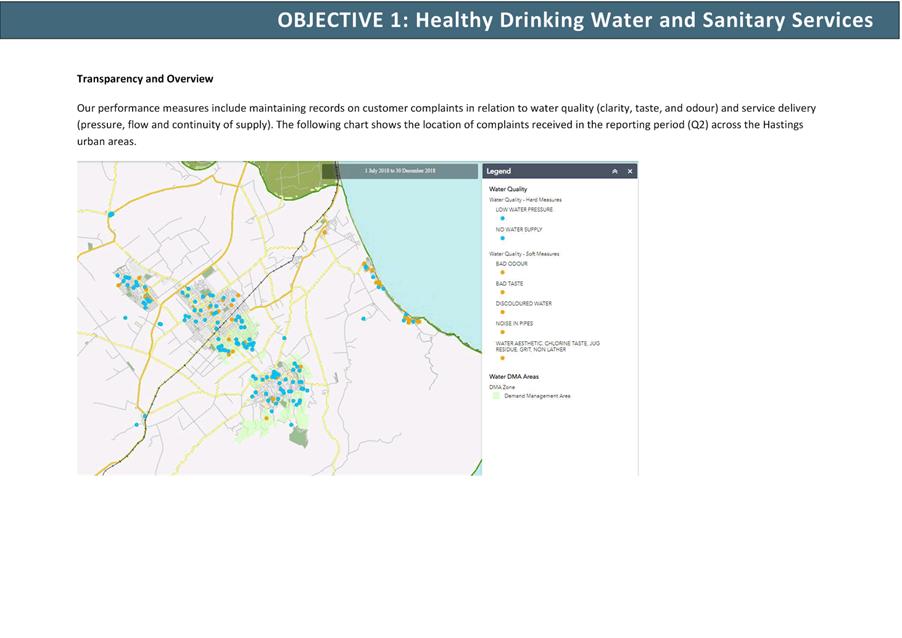

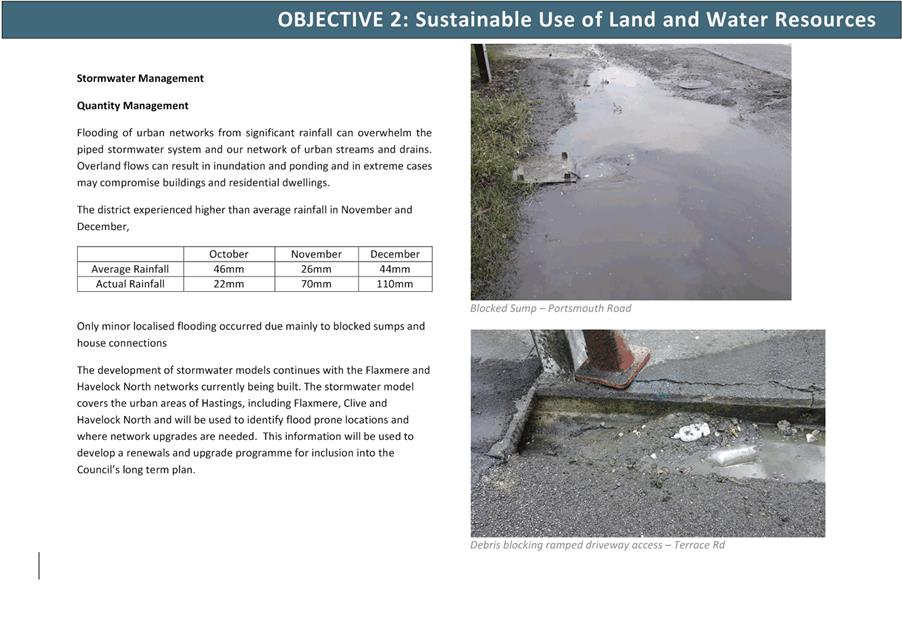

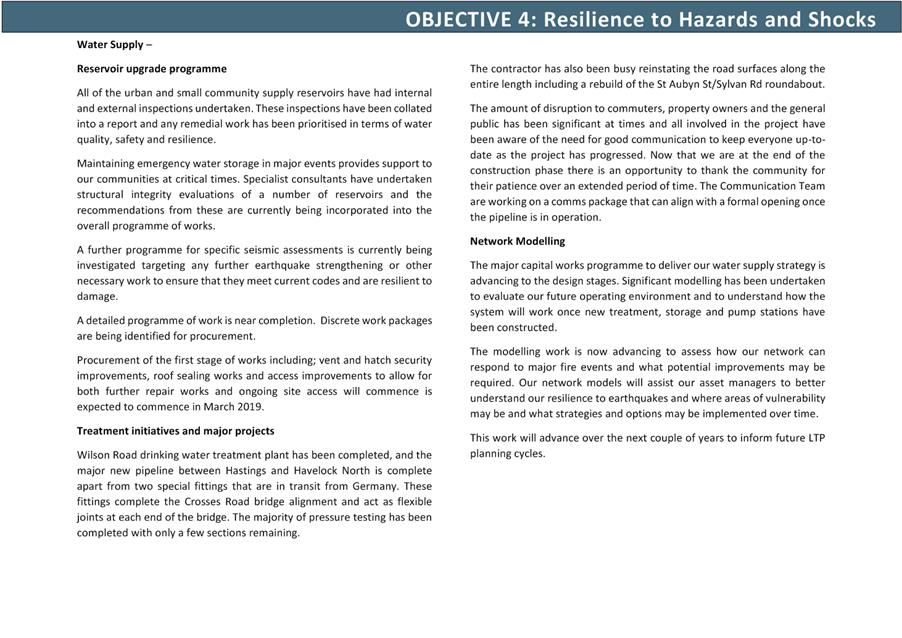



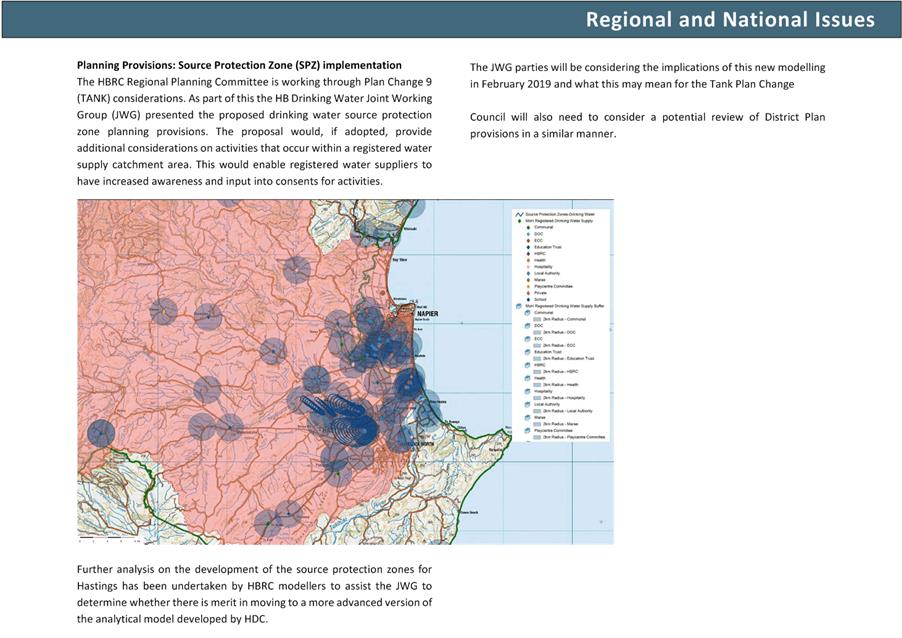
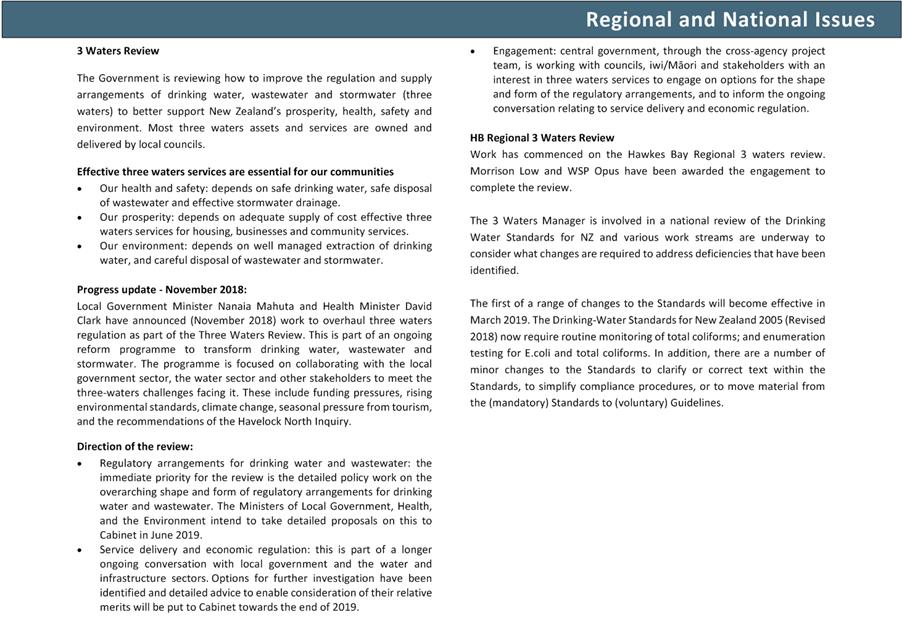
|
Attachment 4 Parks and Buildings 28 February 2019
|
Attachment 4
|
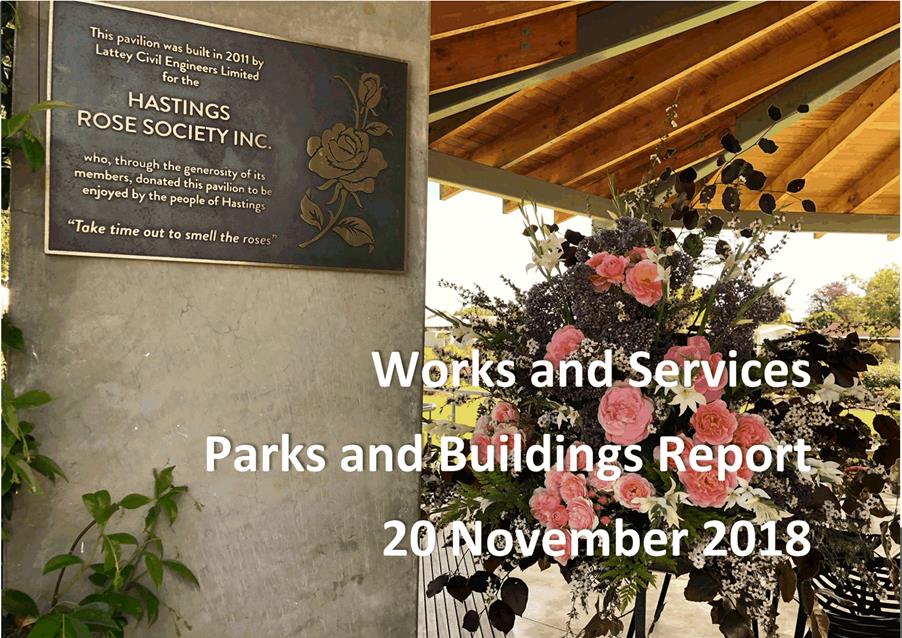

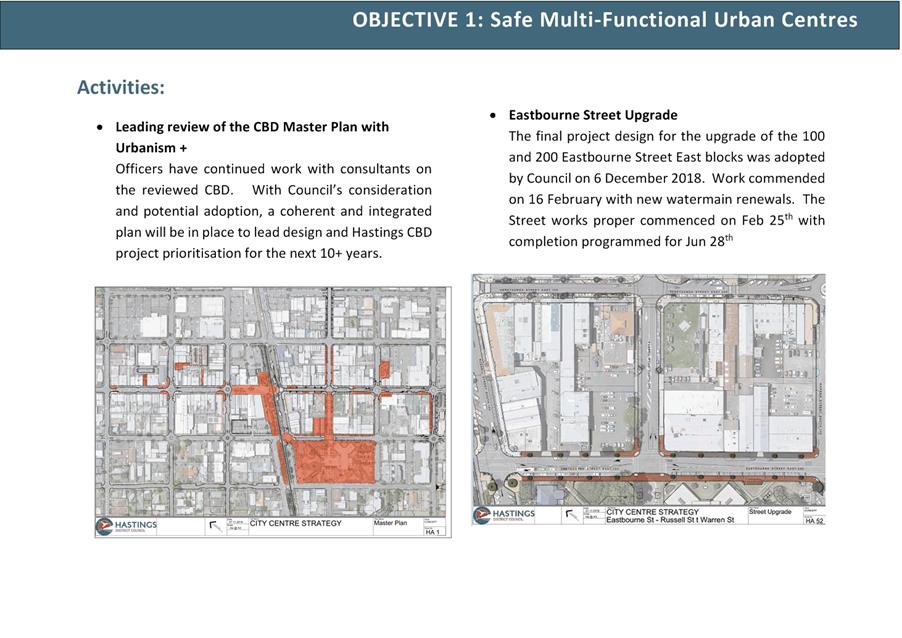
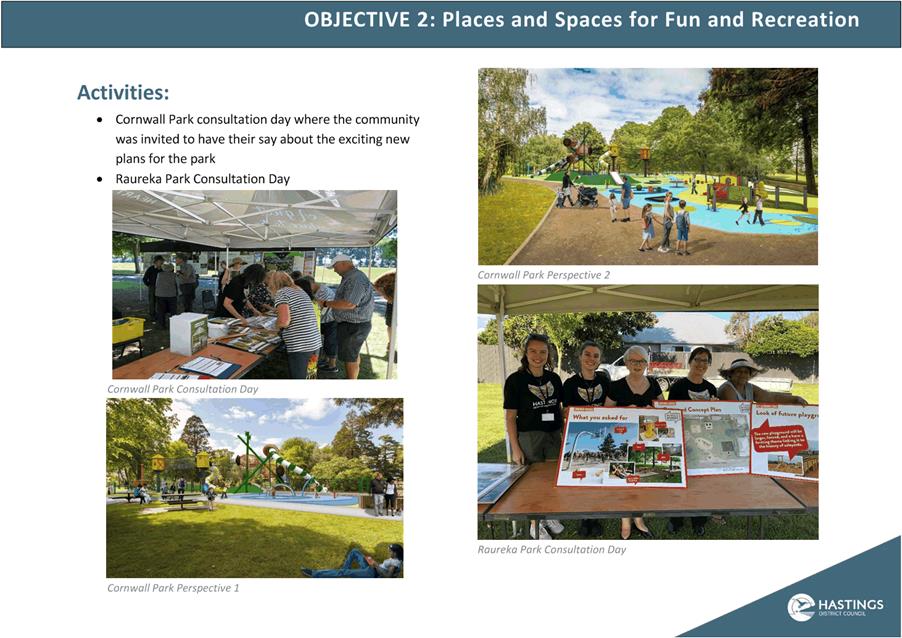

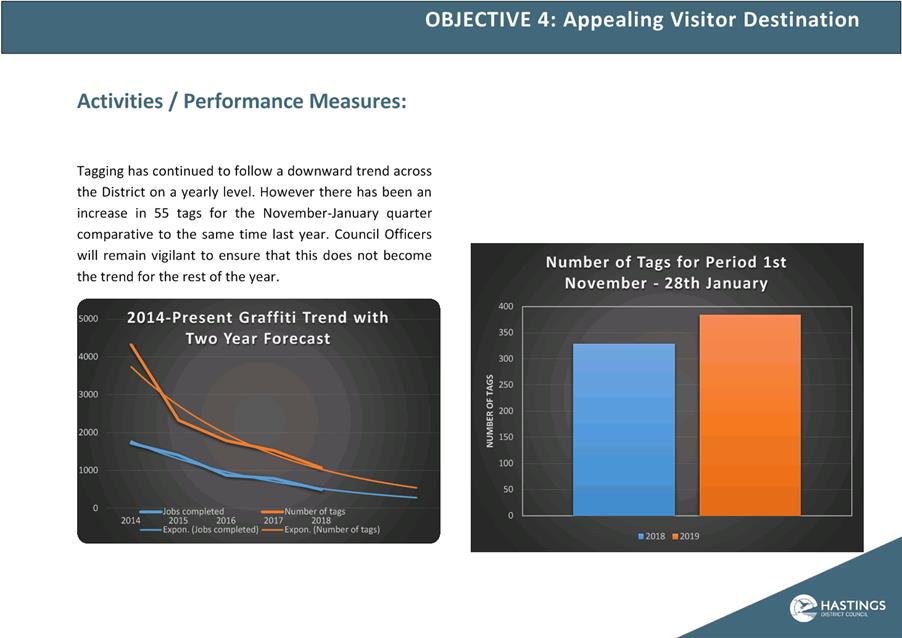

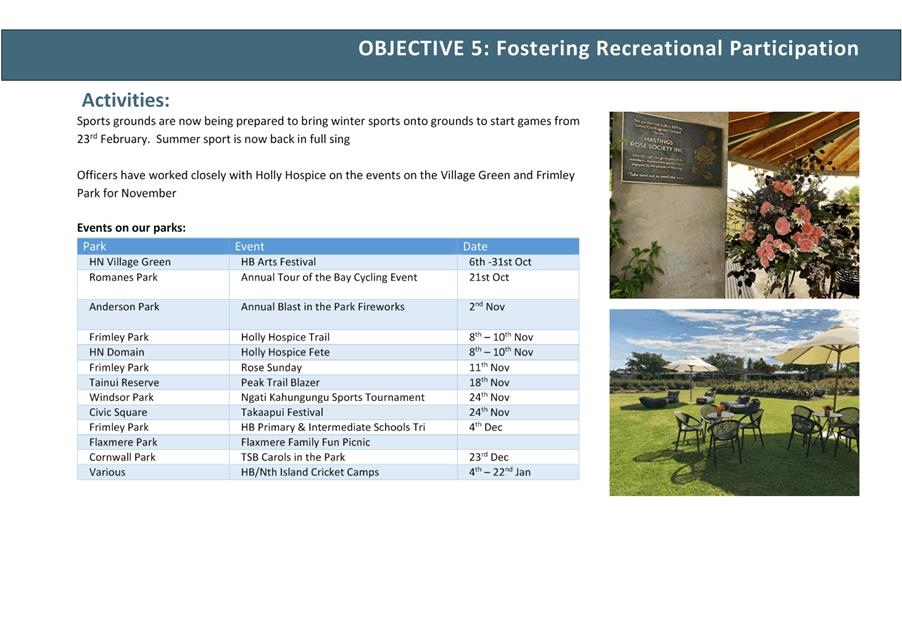
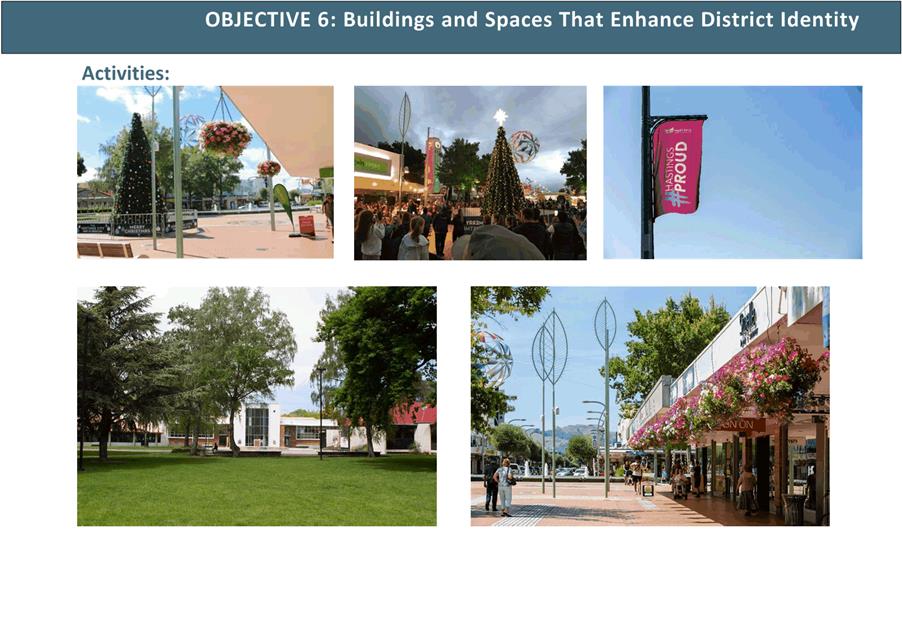
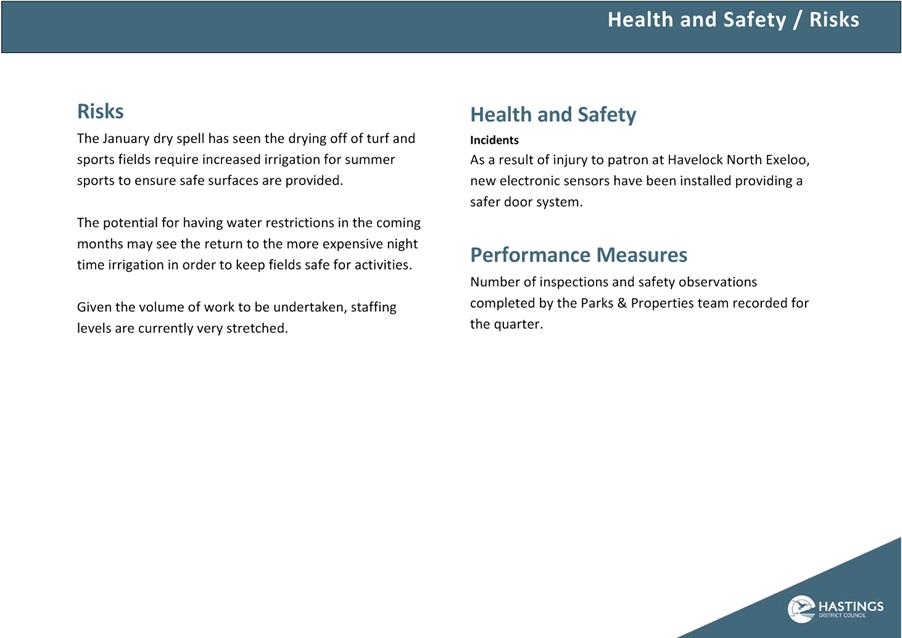
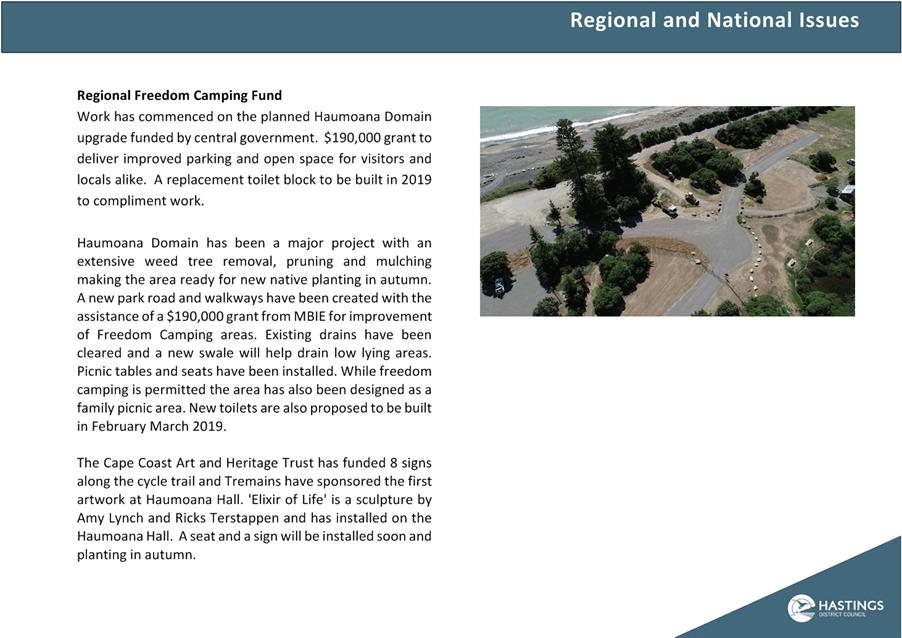
|
Attachment 5 Schedule of Contracts Let
|
Attachment 5
|
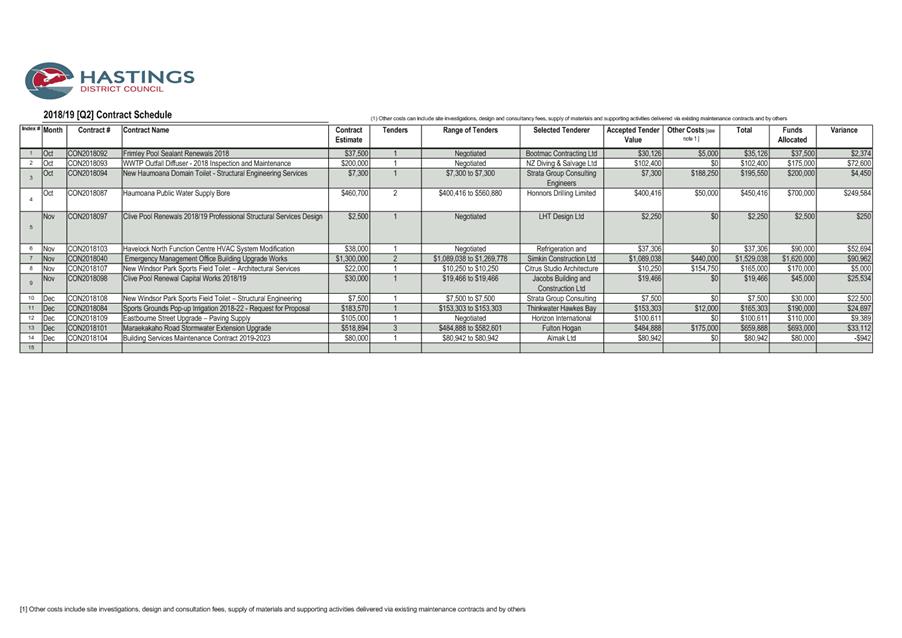
|
Attachment 6 Project Status Report
|
Attachment 6
|
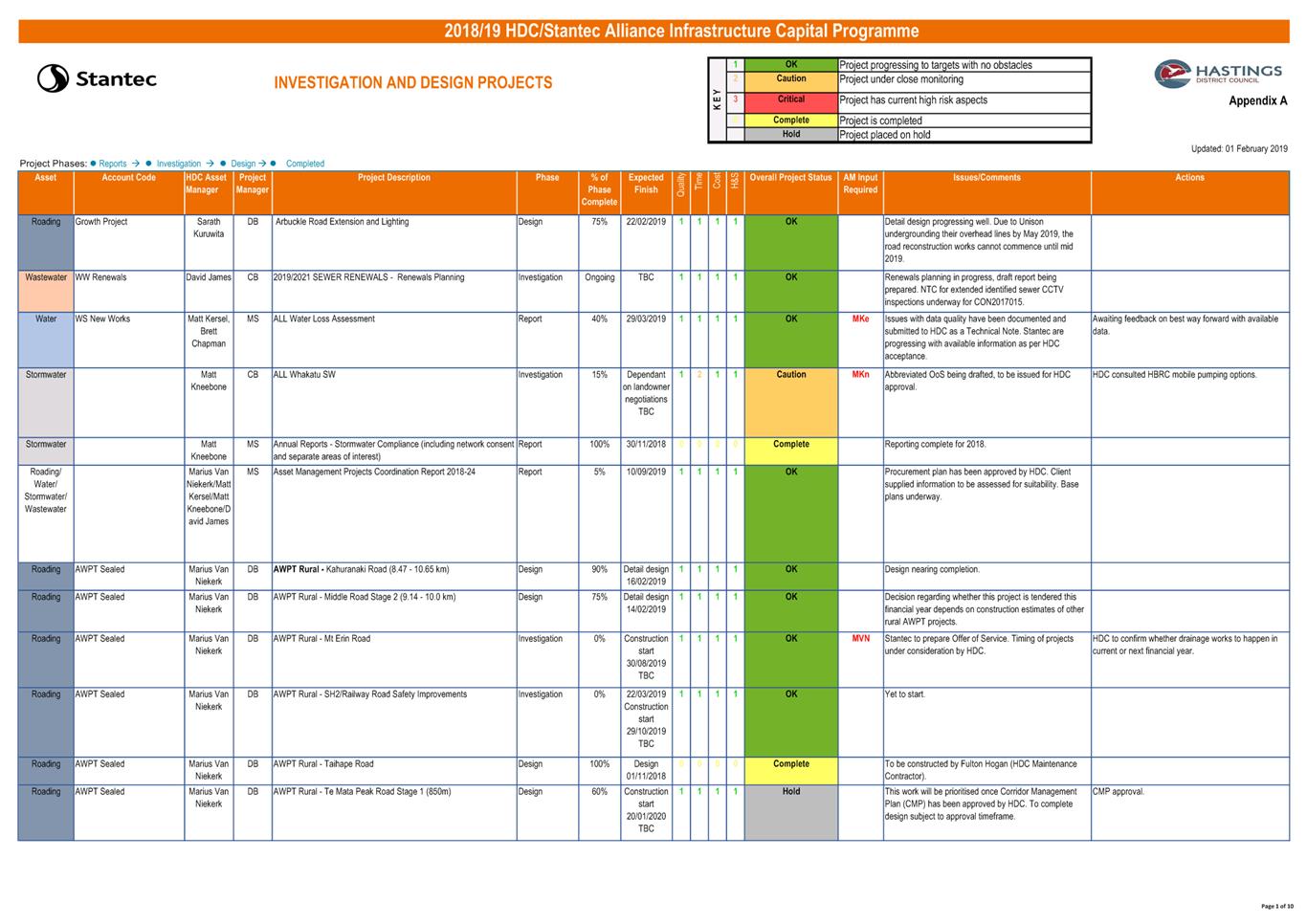
|
Attachment 6 Project Status Report
|
Attachment 6
|
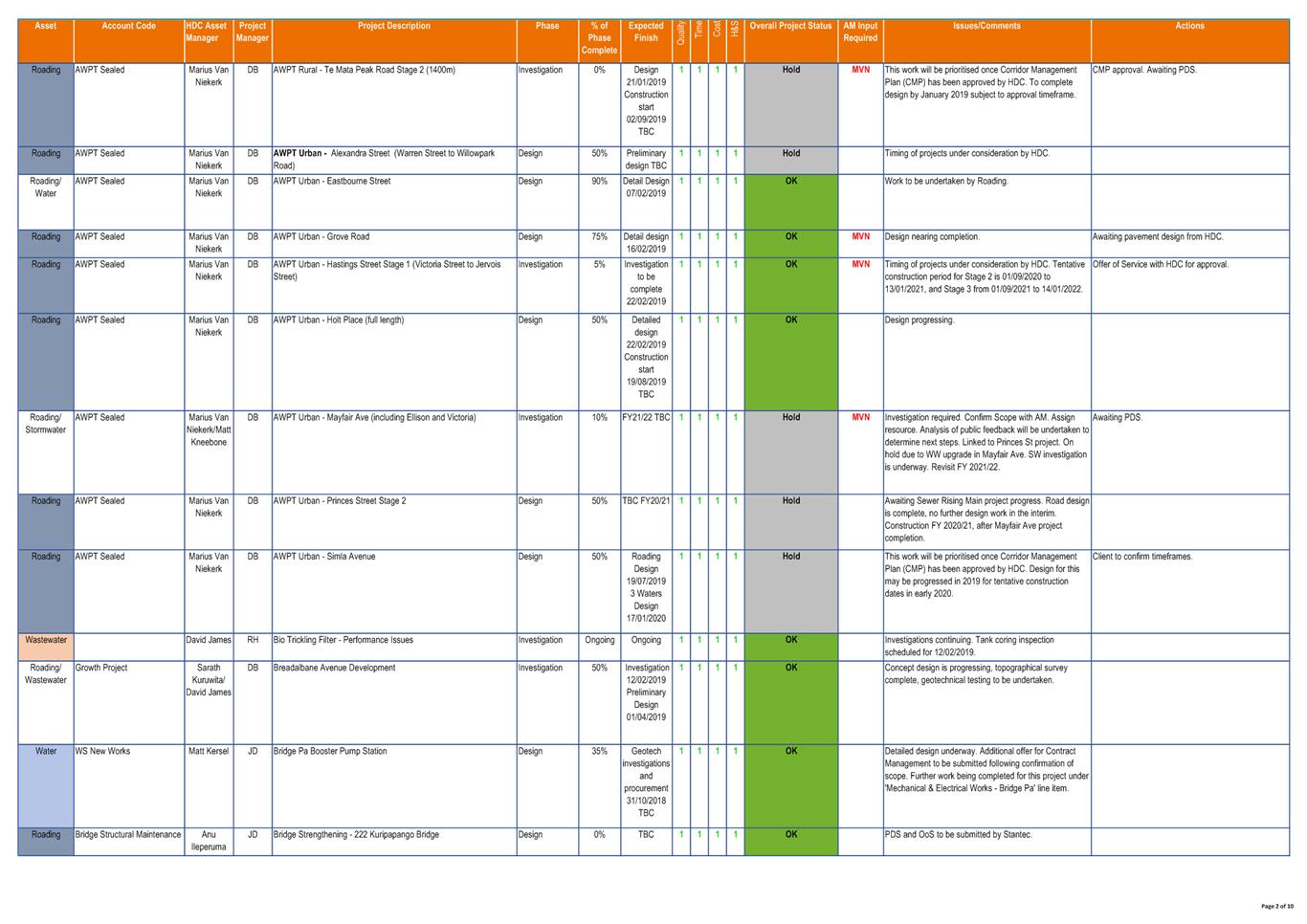
|
Attachment 6 Project Status Report
|
Attachment 6
|
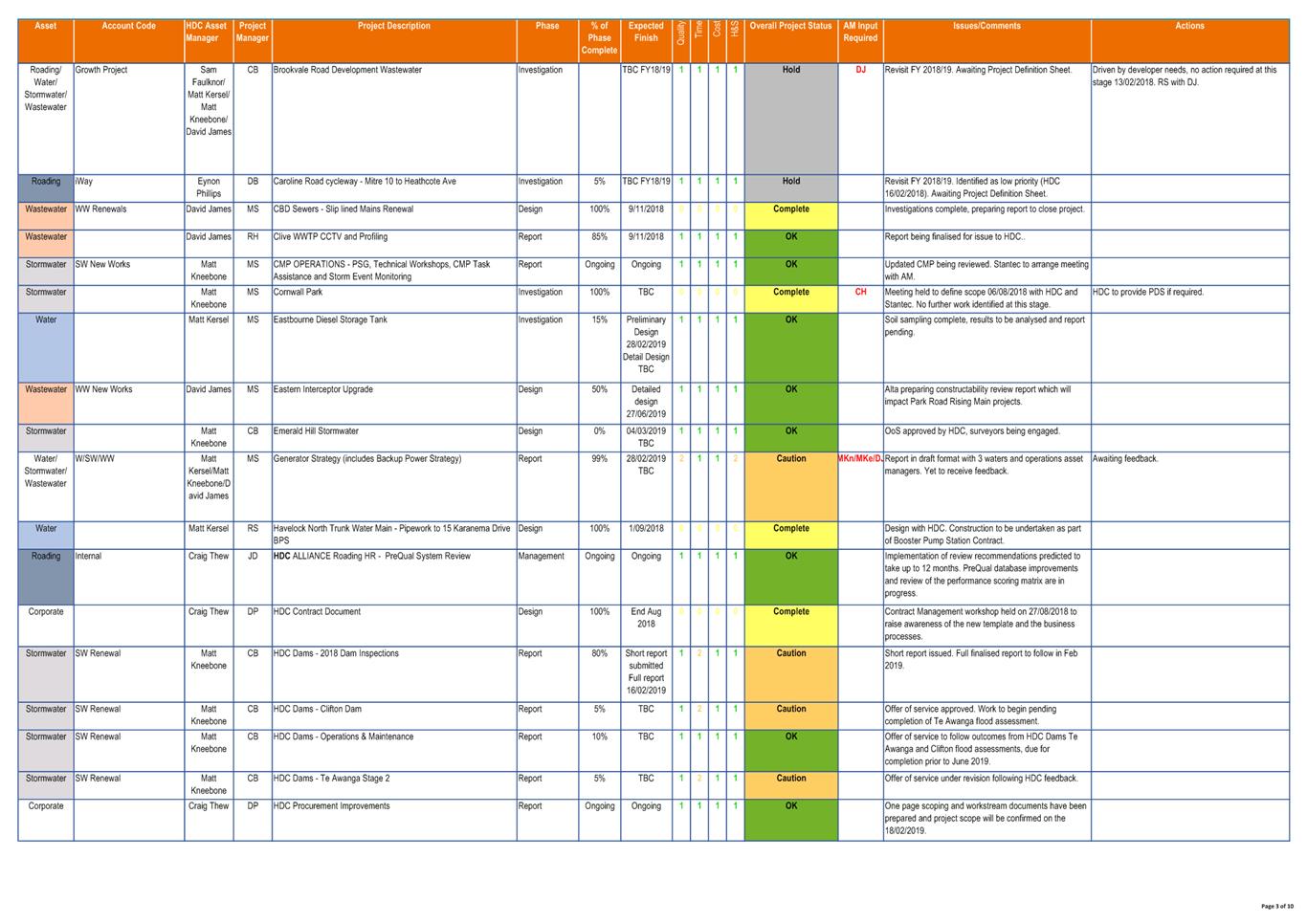
|
Attachment 6 Project Status Report
|
Attachment 6
|
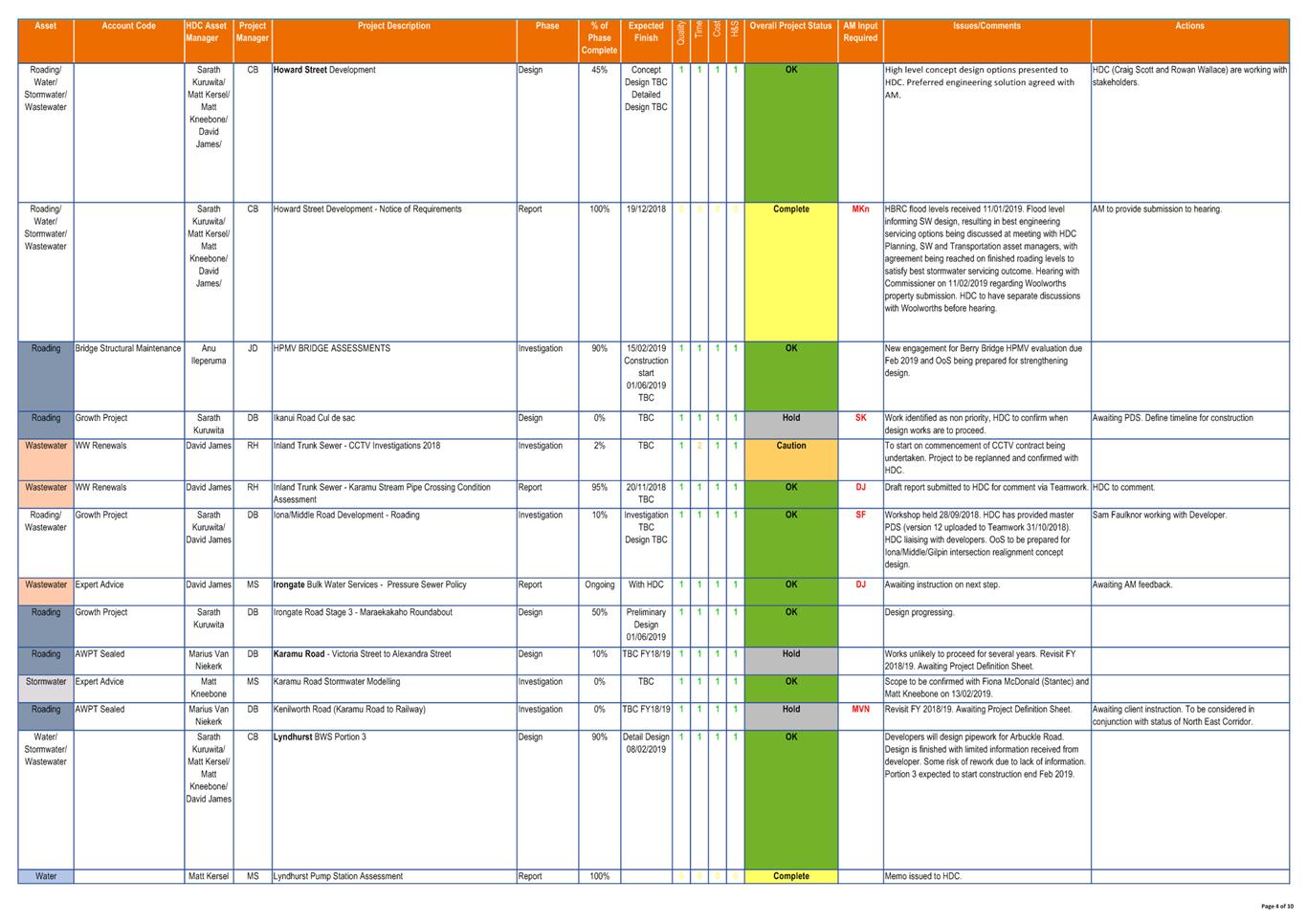
|
Attachment 6 Project Status Report
|
Attachment 6
|
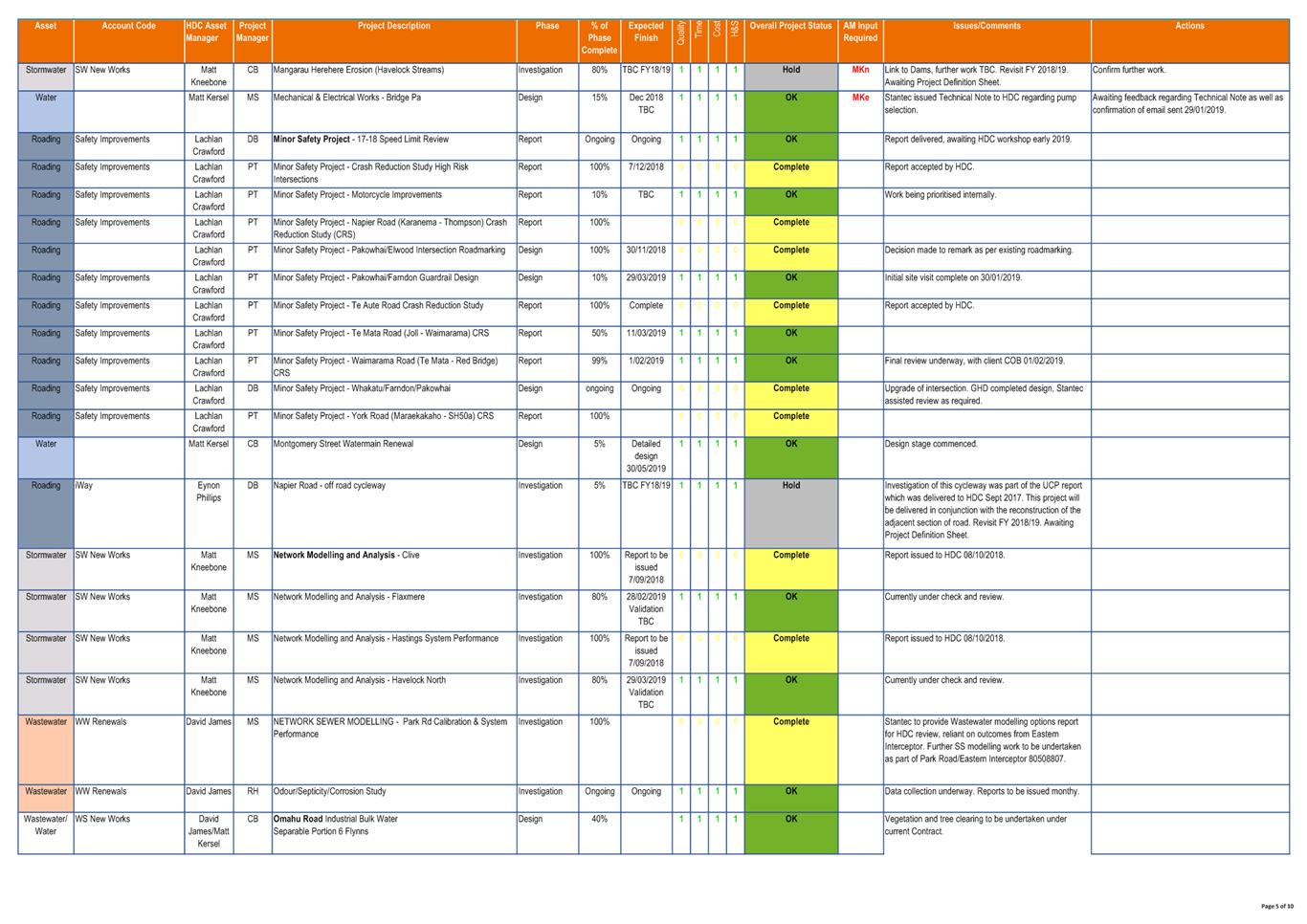
|
Attachment 6 Project Status Report
|
Attachment 6
|
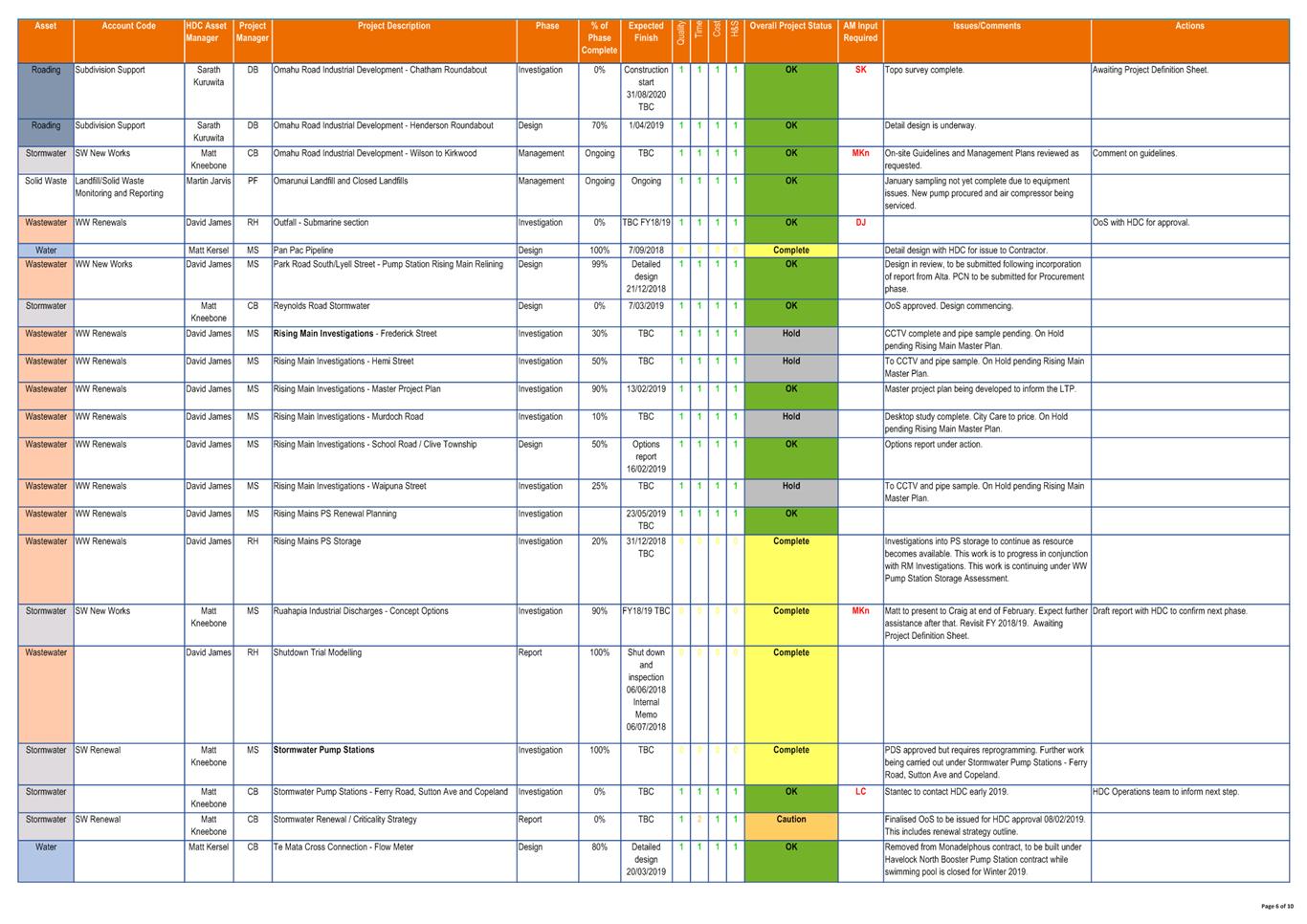
|
Attachment 6 Project Status Report
|
Attachment 6
|
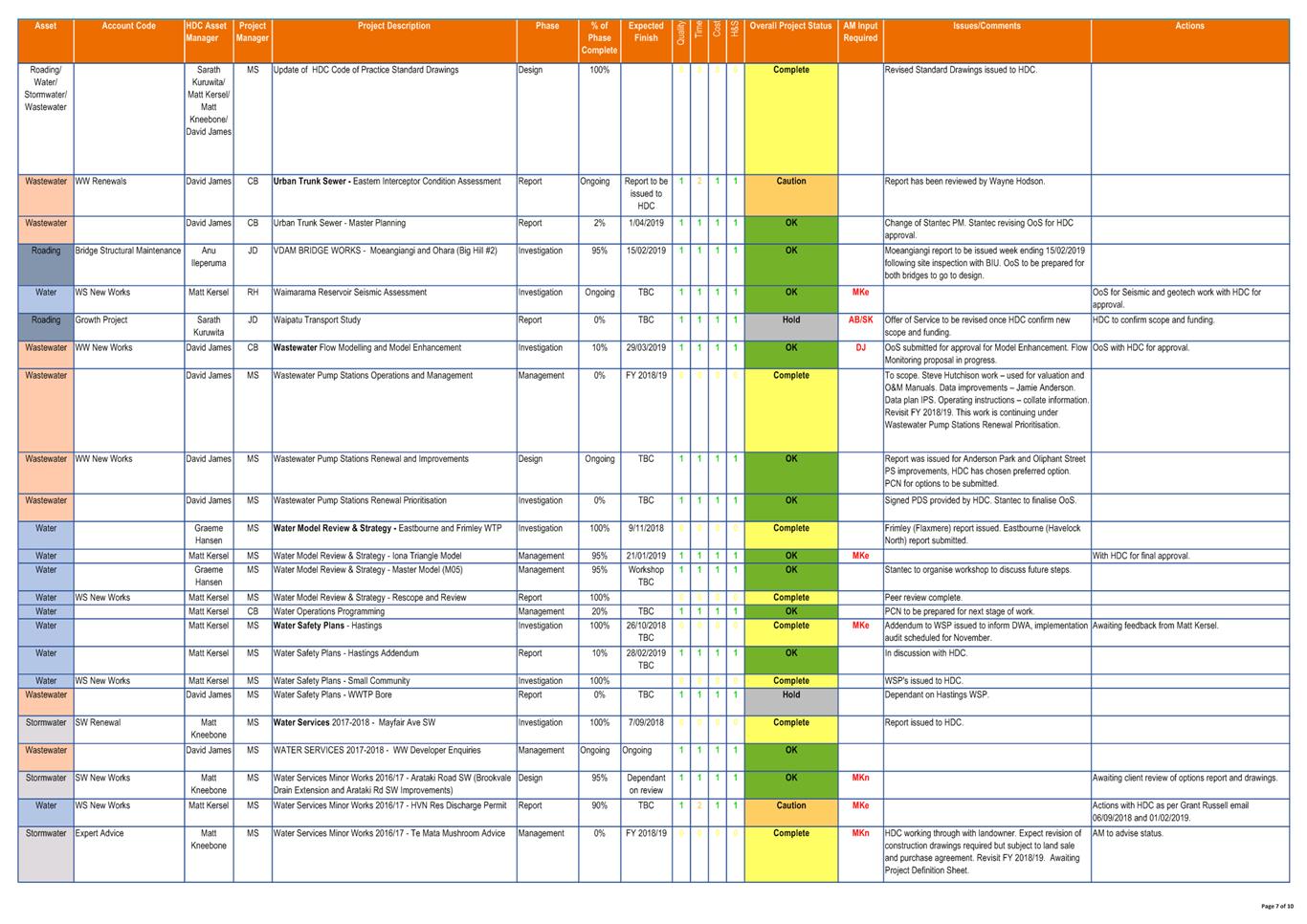
|
Attachment 6 Project Status Report
|
Attachment 6
|
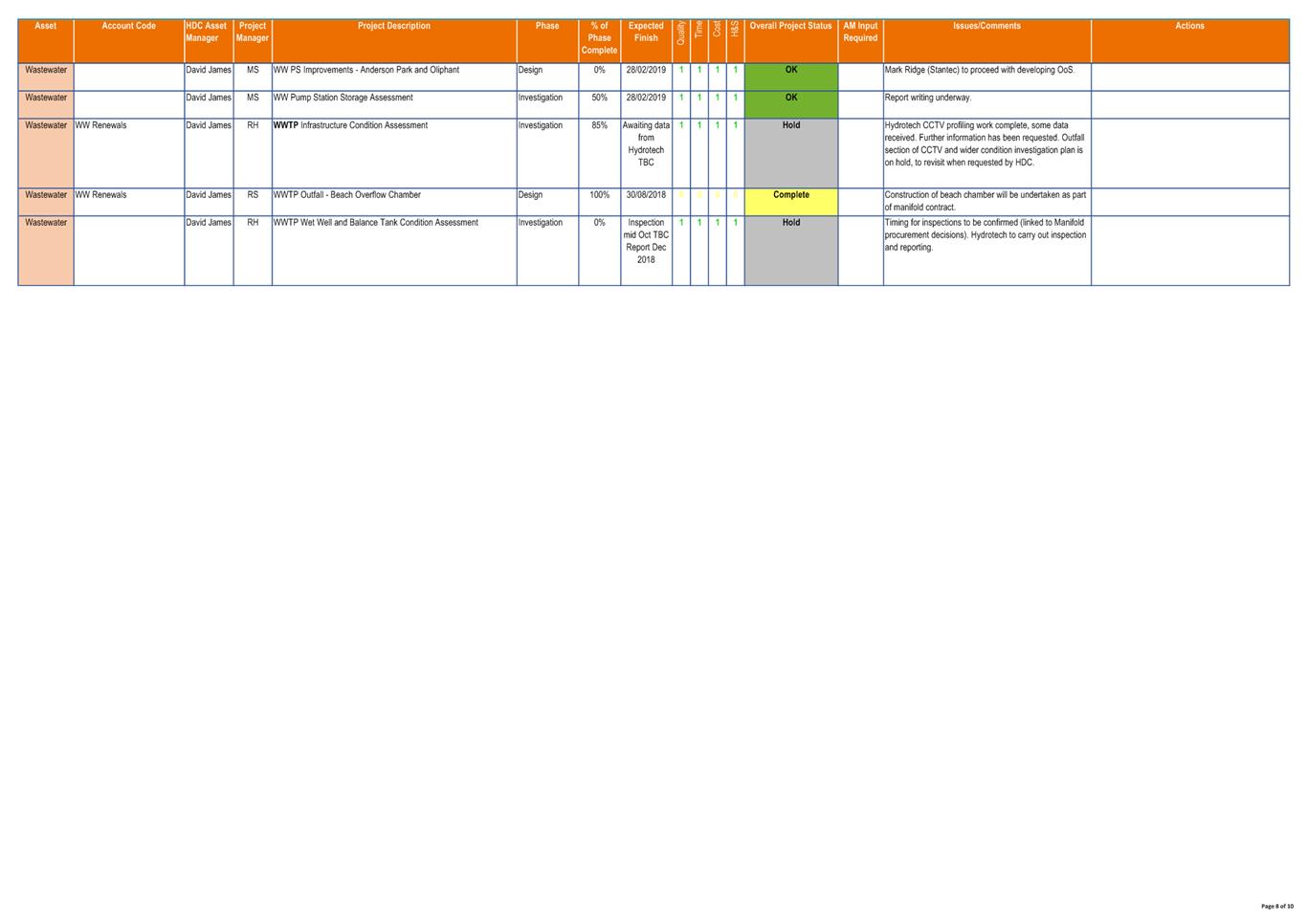
|
Attachment 6 Project Status Report
|
Attachment 6
|
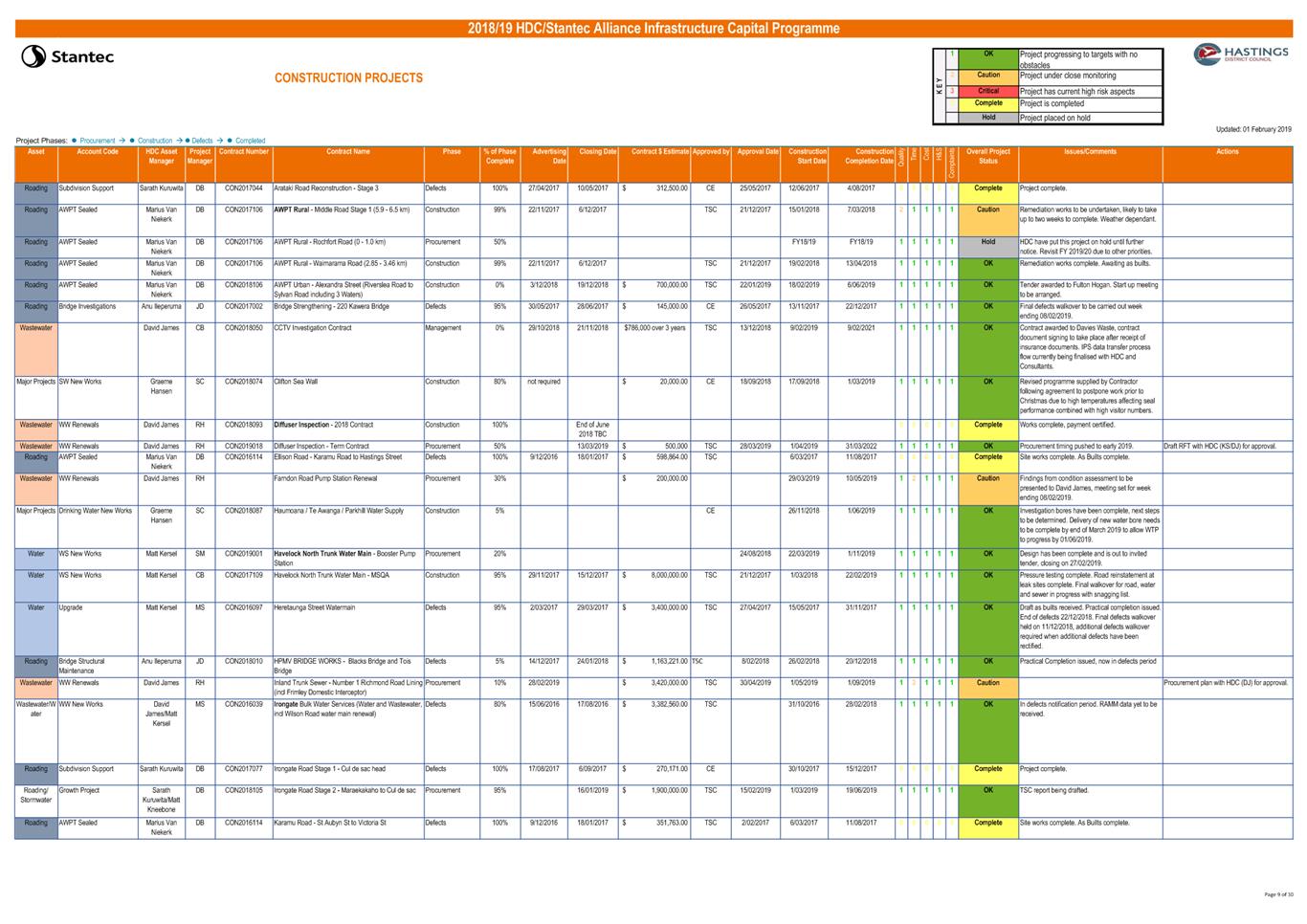
|
Attachment 6 Project Status Report
|
Attachment 6
|
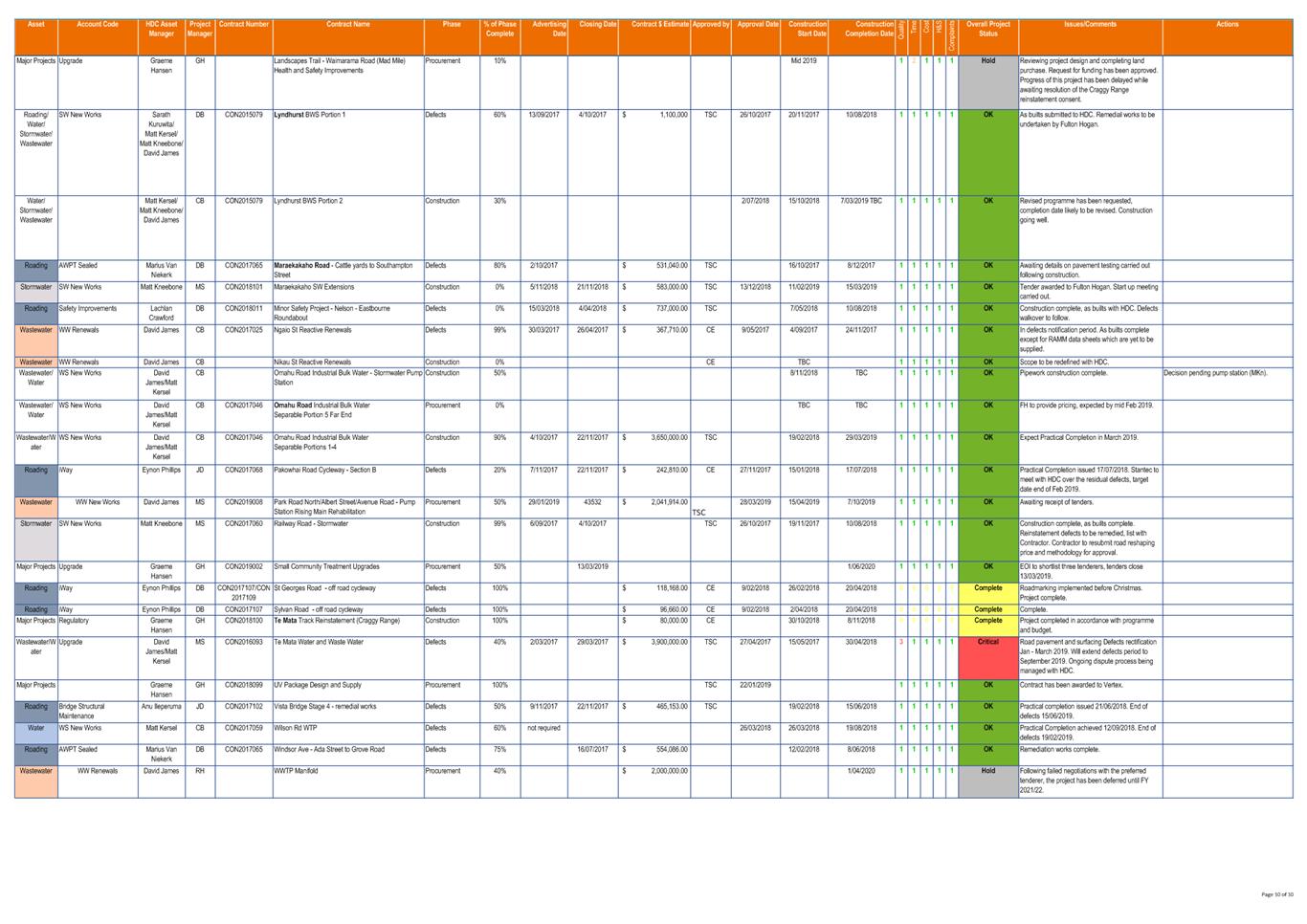
 Hastings District
Council
Hastings District
Council





















































































